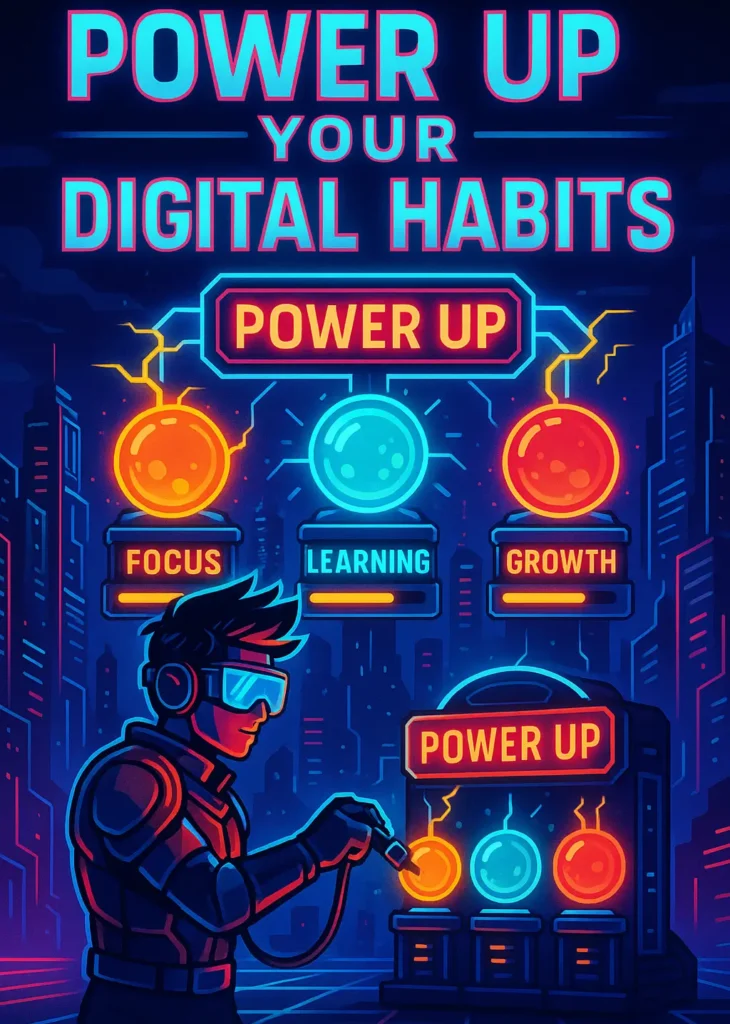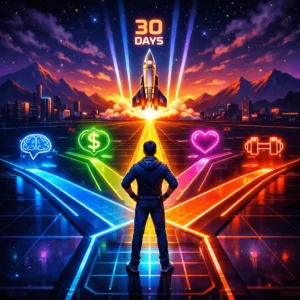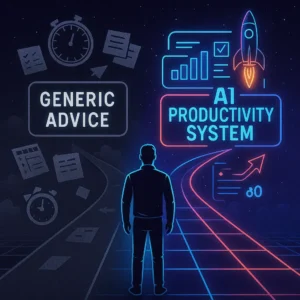Picture this: You’re scrolling through your phone at 11 PM, promising yourself “just five more minutes” before bed. Two hours later, you’re wide awake, overwhelmed by negative news, comparison-inducing social posts, and random videos that add zero value to your life. Sound familiar?
You’re not alone. Research shows that people who implement healthy digital habits see a 73% improvement in digital wellness within just 30 days. The difference? They stopped fighting their technology and started making their screens work FOR their goals instead of against them.
The challenge isn’t technology itself—it’s that most of us are stuck in passive digital habits that drain our energy instead of building it. Traditional digital detox advice tells you to “just put the phone down,” but that ignores the reality of our connected world. Instead, what if you could transform your screen time into growth time?
Growth-Focused Upgrades You’ll Gain:
- Transform mindless scrolling into active learning that builds your expertise
- Optimize your digital environment for focus and creativity
- Convert wasted screen time into skill-building momentum across all areas of life
What are Digital Habits?
Digital habits are simply the routines we form around how we use our phones, computers, and other tech in our daily lives. They’re the things we do without even thinking—like opening social media first thing in the morning or checking emails during lunch.
They can be grouped into a few main types:
- Consumption habits – How we take in online content, like scrolling Instagram, watching YouTube, reading news, or browsing websites. This includes when, where, and how often we do it.
- Communication habits – How we connect with others, such as texting, emailing, video calls, or messaging apps. It also covers how quickly we reply, which apps we use, and our style of communication.
- Work and productivity habits – How we use tech to get things done, like checking emails, using to-do list apps, juggling multiple tabs, or organizing files.
- Entertainment habits – The fun stuff—playing games, watching Netflix, listening to podcasts, or other screen-based hobbies.
- Information-seeking habits – How we look things up, fact-check, research, or keep up with the news.
Just like any other habit, these patterns form through repetition. Some can be helpful—like using a learning app daily—while others can be unhelpful—like constantly refreshing social media.
Why Traditional Digital Detox Methods Fail (And How to Fix Them)
Most digital habits advice focuses on restriction rather than redirection. You’re told to delete apps, use grayscale filters, or implement strict time limits. But here’s the problem: these approaches treat the symptom, not the cause.
Bad digital habits like mindless scrolling, notification addiction, and passive consumption compound into serious life impacts you might not even realize. Studies show that people with poor digital boundaries experience 45% higher stress levels, 38% decreased deep work capacity, and 52% more difficulty maintaining real-world relationships. Your bad digital habits examples aren’t just “wasting time”—they’re actively rewiring your brain for instant gratification, making it harder to focus on long-term goals.
The solution is personalized redirection that transforms your existing digital habits toward growth-oriented outcomes. Instead of generic restrictions, you need intelligent systems that work with your natural patterns while guiding you toward healthy digital habits that actually stick.
7 Powerful Healthy Digital Habits That Turn Screen Time Into Growth
1. Curated Learning Feeds That Replace Mindless Scrolling
Replace random social media feeds with intentionally curated educational content that delivers valuable insights aligned with your goals. This transforms passive consumption into active skill-building.
Implementation Strategy: Use tools like Feedly, Pocket, or Flipboard to create custom feeds focused on your industry, interests, and growth areas. Set up automated filters that prioritize good digital habits examples like industry insights, skill-building tutorials, and growth-oriented podcasts over entertainment content.
The key is specificity—generic “productivity” content won’t work. Be detailed about your goals, current skill level, and preferred learning format. This creates one of the most powerful digital habits examples for professionals who want to turn commute time or coffee breaks into career advancement opportunities.
2. Smart Notification Management for Deep Focus
Most people receive 80+ notifications daily, creating a constant state of reactive distraction. Intelligent notification management batches, prioritizes, and times your alerts for optimal productivity instead of constant interruption.
Implementation Strategy: Create notification rules that only allow urgent communications during focus hours. Use built-in features like iOS Focus modes or Android’s Do Not Disturb to batch non-urgent notifications for designated review times—typically noon and 6 PM work well.
This addresses some of the worst bad digital habits examples like constant email checking and social media notifications that fragment attention. Students especially benefit from this approach—digital habits examples for students show that batched notifications can improve study session focus by up to 60%.
3. Adaptive Productivity Sessions That Work With Your Energy
Instead of rigid time-blocking, create dynamic productivity sessions that adapt to your natural energy patterns throughout the day. This maximizes your peak performance periods while respecting your need for recovery.
Implementation Strategy: Track your energy and productivity patterns for one week using apps like RescueTime or simple time-tracking. Identify your peak focus times, creative periods, and administrative energy windows. Then schedule your most important work during these optimal periods.
This creates healthy digital habits that work with your biology rather than against it. The system learns from your performance data and continuously optimizes your schedule, making this one of the most effective healthy digital habits for knowledge workers.
Read More: How to Be Productive
4. Content Creation That Transforms Consumption into Value
Turn your learning into value creation by processing information and sharing insights with your audience. This transforms you from a passive consumer into an active contributor who builds expertise while helping others.
Implementation Strategy: Set up workflows that capture your learning highlights—whether from podcasts, articles, or videos—and transform them into original insights. Create weekly social posts, blog drafts, or presentation materials that share key takeaways with your network.
This represents good digital habits examples that create compound returns on your screen time investment. Instead of just consuming content, you’re building your professional brand and expertise while helping others—a true win-win scenario.
5. Intelligent Digital Boundaries for Work-Life Balance
Create systems that automatically adjust your digital environment based on time, location, and context to maintain healthy boundaries between online and offline time without requiring constant willpower.
Implementation Strategy: Use location-based triggers and automated schedules to create digital boundaries. Set up “work mode” and “personal mode” configurations that adjust app availability, notification settings, and even device functionality based on your current context and goals.
This directly addresses how you can create a healthy balance between online and offline time by making technology enforce your own boundaries automatically. It eliminates the willpower battle by making healthy digital habits the path of least resistance.
Read More: How to Find Balance in Life
6. Meaningful Social Media Connections Over Algorithmic Feeds
Instead of eliminating social media entirely, curate your feeds and interactions toward meaningful professional and personal relationships while filtering out time-wasting, comparison-inducing content.
Implementation Strategy: Actively curate your social media connections and content. Use platform features like LinkedIn’s industry-specific feeds, Twitter lists focused on thought leaders in your field, and Instagram’s “Close Friends” features to prioritize meaningful connections over algorithmic entertainment.
This transforms some of the most problematic bad digital habits into networking and relationship-building tools. Focus on interactions that add value versus those that drain energy, creating more intentional digital habits that support your goals.
7. Weekly Digital Habit Reflection and Optimization
Implement systems that regularly review how your digital habits align with your personal and professional growth goals, allowing for continuous improvement and course correction.
Implementation Strategy: Schedule weekly 15-minute reviews of your screen time data across all devices. Ask yourself: Which digital activities moved me closer to my goals? Which ones drained energy without adding value? What patterns do I notice, and what adjustments would help next week?
This creates the foundation for all other healthy digital habits by building awareness and accountability. Regular reflection helps you see patterns you might miss and suggests course corrections before bad habits become entrenched.
Read More: Self-Reflection Questions for Growth
Supercharge Your Digital Transformation with AI
Ready to take these digital habits to the next level? Modern AI can dramatically accelerate your progress by personalizing each strategy to your unique lifestyle, goals, and challenges.
Use this AI prompt to create your personalized digital habits plan:
“I want to transform my digital habits from time-wasting to growth-focused. Please consider my specific situation:
Current Challenge: [Describe your biggest digital habit challenge – e.g., “I spend 3 hours daily scrolling social media instead of learning new skills”]
My Goals: [List 2-3 specific goals – e.g., “Advance in my marketing career, start a side business, improve work-life balance”]
My Lifestyle: [Describe key factors – e.g., “Remote worker, morning person, have 2 young kids, commute 1 hour daily”]
Strengths: [List 2-3 strengths – e.g., “Good at following systems, love learning, tech-savvy”]
Based on this information, please:
- Identify which of the 7 digital habits above would have the biggest impact for my situation
- Create a specific 30-day implementation plan for my top 3 habits
- Suggest good digital habits examples that fit my schedule and goals
- Provide specific apps, tools, and automation ideas for my situation
- Create accountability check-ins and success metrics I can track weekly
Make the plan specific to my lifestyle and realistic to implement.”
Why This Works: The more specific details you provide about your situation, the more personalized and effective the AI recommendations become. This approach transforms generic advice into actionable strategies that actually stick.
Real-World Success: How Sarah Transformed Her Digital Life
Sarah, a 28-year-old marketing manager, was spending 4+ hours daily on her phone, mostly scrolling social media and news sites. After implementing these growth-focused strategies, she reduced mindless screen time by 67% while actually increasing her professional development and career growth.
Her transformation started with replacing her 2-hour morning social media habit with curated industry newsletters, LinkedIn learning courses, and podcasts from marketing leaders. She used the notification batching technique to eliminate constant interruptions during work hours.
Within 30 days, Sarah had completed 12 professional development modules, connected with 15 industry contacts, and launched a side project that generated her first $500 in freelance income. The key was redirecting existing habits rather than eliminating them entirely.
Sarah’s success came from treating her digital habits as powerful tools that could either advance or derail her goals—and choosing to optimize them for growth instead of entertainment.
Conclusion – Healthy Digital Habits:
Implementing healthy digital habits requires patience, consistency, and self-compassion. Start by choosing one or two habits that resonate most strongly with you rather than attempting to change everything at once. Gradual implementation allows new behaviors to become natural parts of your routine rather than burdensome obligations.
Remember that the goal isn’t to eliminate technology from your life but to use it more intentionally. When digital tools serve your purposes and support your well-being, they become valuable allies. By developing these healthy digital habits, you can enjoy the benefits of our connected world while maintaining balance.
🚀 YOUR DIGITAL TRANSFORMATION STARTS HERE
You’ve discovered how to transform your digital habits from time-wasters into growth accelerators. But implementing these strategies individually is just the beginning.
What if there was a comprehensive system that brought all these elements together—one that not only optimized your digital life but helped you build unstoppable momentum across all areas that matter: your mindset, career, relationships, physical health, and emotional wellbeing?
The strategies you’ve learned are powered by the AI Habits Coach—a gamified, AI-enhanced platform that makes healthy digital habits part of a complete life transformation. Our system doesn’t just manage your screen time; it personalizes your entire growth journey across all 5 Core Areas of Life, using the same behavioral science principles that make apps addictive, but redirected toward your personal growth.






